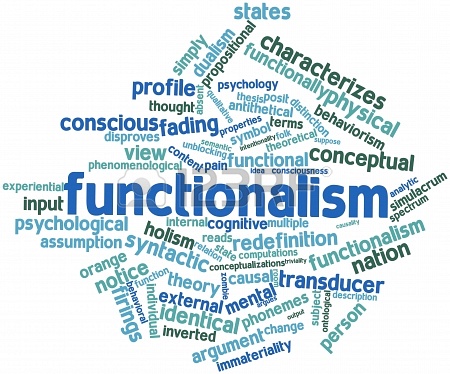MOVING BEYOND LIMITED EFFECTS: FOCUS ON FUNCTIONALISM AND CHILDREN
Functionalism Theoretical approach that conceives of social systems as living organisms whose various parts work, or function, together to maintain essential processes
Communication systems theory Theory that examines the mass communication process as composed of interrelated parts that work together to meet some goal
Social cognitive theory Theory of learning through interaction with the environment that involves reciprocal causation of behavior, personal factors, and environmental events
THEORIES OF THE MIDDLE RANGE AND THE FUNCTIONAL ANALYSIS APPROACH
Merton (1967, p. 68) described middle-range theory as follows:
- Middle-range theories consist of limited sets of assumptions from which specific hypotheses are logically derived and confirmed by empirical investigation.
- These theories do not remain separate but are consolidated into wider networks of theory.
- These theories are sufficiently abstract to deal with differing spheres of social behavior and social structure, so that they transcend sheer description or empirical generalization.
- This type of theory cuts across the distinction between micro-sociological problems.
- The middle-range orientation involves the specification of ignorance. Rather than pretend to knowledge where it is in fact absent, this orientation expressly recognizes what must still be learned to lay the foundation for still more knowledge.
Manifest functions Intended and observed consequences of media use
Latent functions Unintended and less easily observed consequences of media use
Classic four functions of the media Surveillance, correlation, transmission of the social heritage, and entertainment
Mass entertainment theory Theory asserting that television and other mass media, because they relax or otherwise entertain average people, perform a vital social function
SYSTEMS THEORIES OF COMMUNICATION PROCESSES
A system consists of a set of parts that are interlinked so that changes in one part induce changes in other parts. System parts can be directly linked through mechanical connections, or they can be indirectly linked by communication technology. Because all parts are linked, the entire system can change as a result of alterations in only one element. Systems can be goal-directed if they are designed to accomplish a long-term objective. Some systems are capable of monitoring the environment and altering their operations in response to environmental changes.
THE RISE OF SYSTEMS THEORIES
The rise of functionalism, middle-range, and systems theories in the 1950s and 1960s encouraged theorists to move beyond simplistic, fragmented, linear models of mass communication. At a time when limited-effects notions dominated, functionalism’s value-neutrality was attractive to researchers and theorists studying media’s influence, especially as functional analyses accepted the presence of latent as well as manifest functions. The strategy of developing middle-range theory offered hope of moving beyond the empirical generalizations produced by run-of-the-mill effects research. These generalizations could be “added up” to create broader theories of media. Ultimately, functionalism’s promise to more meaningfully alter the direction of mass communication theory was weakened by its inability to draw definitive conclusions about effects and by what many saw as its status quo orientation, as exemplified by research on the narcotizing dysfunction and mass entertainment theory.
Some mass communication researchers looked to a concept related to functionalism developed by communications engineers, systems, which evolved from cybernetics, the study of the regulation and control of complex machines. Systems consist of sets of parts interlinked so changes in one part induce changes in other parts. Systems theory allows the creation of models demonstrating the interdependence, selfregulation, and goal-orientation of systems. The application of systems theories to mass communication raised many important questions that forced reconsideration of the limited-effects perspective.
Reconsideration of limited-effects thinking about media also came from people interested in the influence of mediated violence on subsequent viewer aggression. Television and children were the focus of this inquiry.
Defense of the media (and the limited-effects perspective) came from proponents of catharsis, the idea that viewing violence substitutes for the actual demonstration of aggression by the viewer. But this theory was ultimately discredited as social cognitive theory became widely accepted.
Social cognitive theory proved to be a useful way of understanding how people learn behaviors from television. By differentiating between imitation and identification and identifying several different modeling processes, such as observational learning, inhibitory and disinhibitory effects, and vicarious reinforcement, it helped explain how individuals learn from the media. Even as these ideas have been applied to “new” media such as video games, they have left many questions unanswered, especially as these insights were extrapolated from micro-level analyses (where they were initially formulated) to more macro-level explanations of effects.
Research regarding aggressive cues and priming effects attempted to add some specificity to social cognitive theory, as did the developmental perspective. Another advance was the consideration of different contextual variables, aspects of the presentation of violence in the media content itself, in determining the amount of learning from viewing. Still another was a reconception of the young audience—the active theory of television viewing—that, although not dismissing media effects, did suggest that young viewers have more influence over their interaction with media than social cognitive theory seemed to imply.
The demonstration of significant media effects on individuals naturally led to the critical study of larger, macro-level effects, especially in the realm of mass communication and the socialization of children. Early notions of media as an early window on the world have recently been updated and expanded into important work on the redefinition, or even the loss, of childhood itself.
